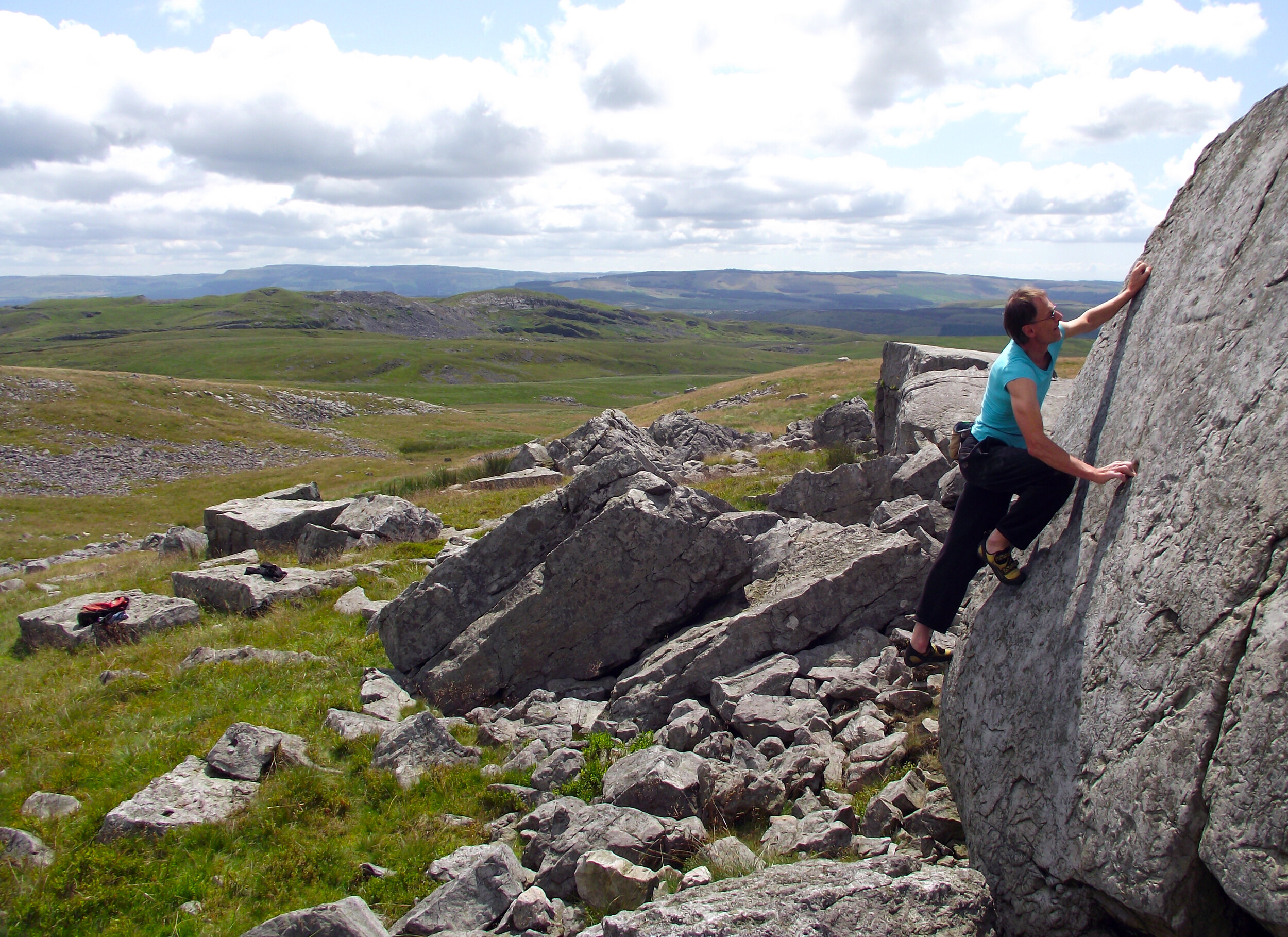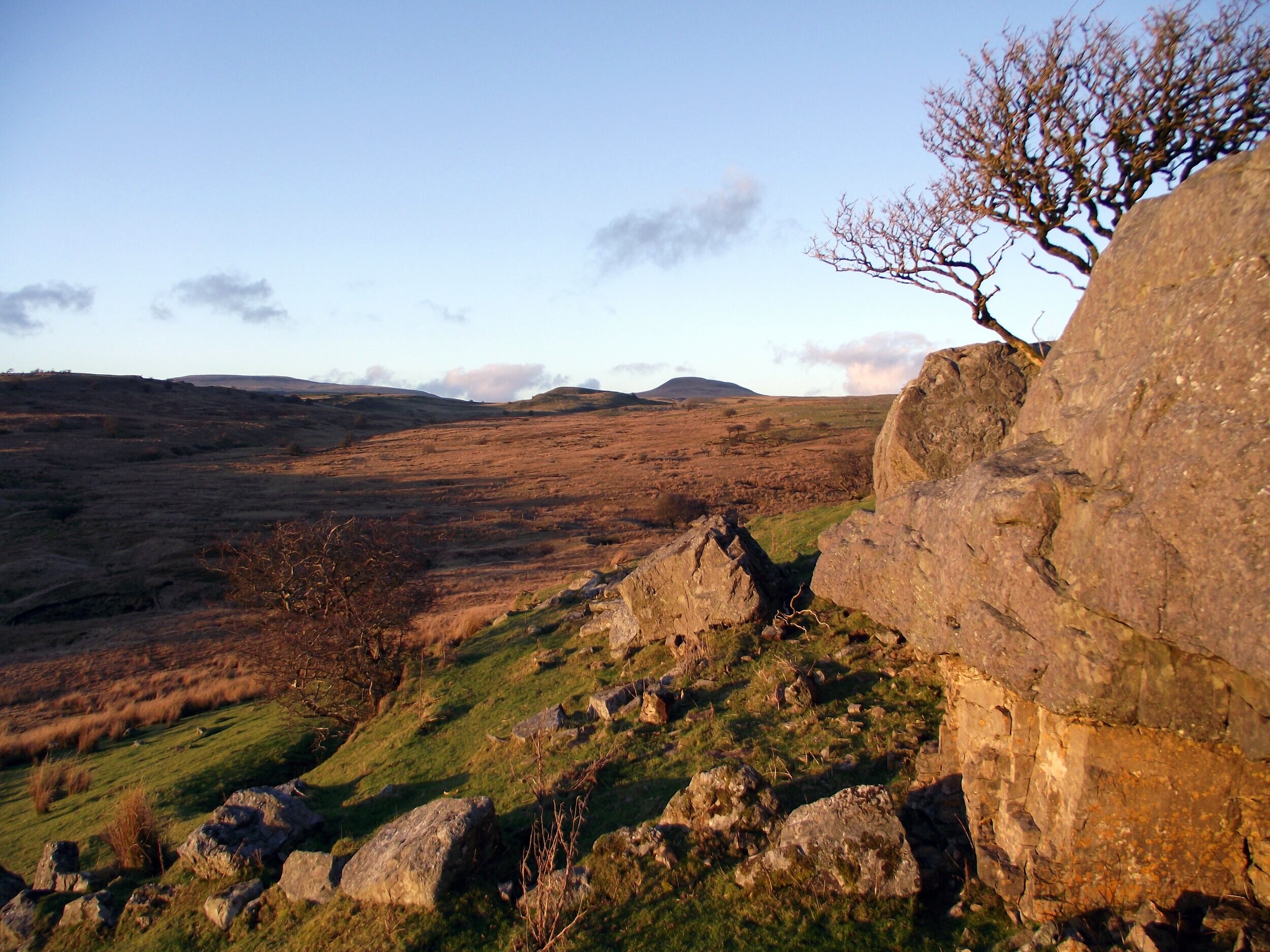
Above: Open Heart (V0-), Dyffryn Sych, Glyntawe. Pic: Beverley Crocker
Brecon Beacons National Park
Something hidden. Go and find it.
Go and look behind the Ranges --
Something lost behind the Ranges.
Lost and waiting for you. Go!
From The Explorer, by Rudyard Kipling
Why jostle for room to breathe on Pen-y-Fan? Instead throw some rock shoes in your sack and head west from Craig-y-Nos deep into the soul of Twrch Sandstonelands, nose to the gritstone. There you’ll find rolling moorlands pitted with sinkholes and craggy tops peppered with boulders. An escape room of wilderness bouldering, among healing hills.
The rock-climbing history of the BBNP is space dust for the imagination. A few have rebound from the traditional limestone quarries on routes travelled by less, gripped by wanderlust. Purring and plundering they have now charted all the bluffs and boulders, their findings represented in a series of modest guidebook topos which you can download here. The National Park boundary binds the climbs, if loosely wrapped; a Christmas stocking of quartz jewels delivered under Dark Skies. OK, there’s little that’s very hard here and ‘bouldering machines’ may bore readily if legs do not fold first. But surely climbing is but a vehicle to discover the heart of a place.
Right: The Arête (V1), Herbert’s Quarry. Jonathan Crocker climbing. Pic: Martin Crocker
Some other Sites in South East Wales
Expect little and you won’t be disappointed, knowing that ‘The least obtrusive pleases most’ (Hannah Moore). I’ve put together a few topos of ‘b-side’ crags that are off the beaten track; for that reason alone, they’re probably worth visiting. The topos were prepared some years ago, so maybe the crags are now bursting with visitors.
Back to the Black is a short article in Climb in 2008 which reflects upon developments in the 2000s on the Abergavenny escarpment (yes, also in the BBNP) including on various new walls and Gilwern East (long before the bolts arrived there).
Set to Stun is a report on spectacular additions to the grossly overhanging Phaser Wall, Ogmore published in Climb in 2008 (pics by Carl Ryan and Martin Crocker). It includes a rudimentary topo of the wall (which I might improve upon as a download some time).
At some stage I’ll run off a feature on the deep water soloing at Ogmore, including tips and topos.
Left: Leia (E1 5b), Darren Cruglwyn, the first ascent (2016). Pic: Jonathan Crocker
Bolting policies: Gower & South East Wales
For 40 years the role of bolts in Gower and South East Wales climbing has proved a hot topic.
After serious bolting conflicts (mostly elsewhere in Britain), the BMC in the 90s set about facilitating local democratic processes to enable climbers to agree policies defining where bolts could be placed and where they should not be placed. Area bolt policies for Gower & South East Wales were thus formulated, and have been repeatedly tweaked and ultimately moulded ad hoc to suit contemporary local tastes. Initially the policies did a reasonable job of striking a fair balance between preserving opportunities for both trad climbing and for increasingly popular sport climbing – and people tended to stick with what was agreed. Since around 2003/4, subtle and unsubtle forces conspired to change all that, and more and more contraventions of the bolt policy took place including the extensive retrobolting of existing trad routes while failing to consult with the first ascensionists of the routes in question. In default of the BMC Area, individual first ascensionists were left to repair the damage to the affected routes as best they could. Unbelievably it’s still happening – evidencing the blind eye being given to the skewing of the processes the BMC initiated in good faith and with a principled agenda many years ago.
Currently there is a new round of bolt policy development for the Area – an absolute golden opportunity to regroup – if not with hugs all round. On the face of it this is a big opportunity to reconcile major differences, to rectify past policy contraventions and to prevent further divisive retrobolting incidents; and to create a sensible outlook for all styles of climbing to co-exist without one threatening the other – and then to stick with what is agreed. Localism is indeed important, but these climbs are national assets too.
At the request of a climbing partner, I made comments on the draft bolt policy and forwarded them to the BMC for onward transmission ‘to whom it may concern’. I’ve attached that commentary here; it’s already public anyway. I’ve done this to help foster access to a broader register of positions being taken on ethics in relation to Gower and South East Wales climbing. Reading my commentary will have greater meaning if considered alongside the draft I commented upon, so here it is.
Right: ‘Father’ of the house of trad John Harwood on Rams Grove Crag, Gower where a ‘no bolting’ policy applies. Pic: Carl Ryan
Ogmore ‘Deep’
Aptly described as Little Big Crag (or is it a ‘Big Little Crag’?) by Pat Littlejohn and Chris Howes in their Mountain mag exposé of 1983, Ogmore presents a taunting reminder of the diversity of SE Wales climbing and how extraordinary it can be. As steep as they come, Ogmore’s impending walls, roofs, and crisp-like Liassic banding blow minds as well as arms. Such is the physicality of the routes, ‘give-it-a-goers’ exhaust themselves as they adjust to all the dead-hanging out in space, their payload of cams aiding gravity. All the while a sense of urgency, if not panic, is unsettled further by the crescendo of manic Bristol Channel tides rumbling and racing in towards them. Today, Ogmore stays relevant, spiritually intact, and accessible. It is the spell-binding monster behind the door you dare not open.
I’ve started preparing a deep water soloing topo for Ogmore, unfortunately missing this 2021 season, though it will be ready for the next. Its focus is the two main DWS zones: Tiger Bay and Dave Jones’ Locker cave. But soloing here isn’t for everyone, and neither is there any expectation that it could ever be. It’s super-serious notwithstanding all the science of the tides, depth calculations, and low water walk-pasts – and the sorcery of happy waterwings.
Meirionnydd
John Sumner’s inspiration, an ancient county, quiet in tall shadows cast by Snowdonia and its luminaries. A vast craggy sometimes forgotten land, ‘mid-Wales’ to invading English prospectors, brought into relief by its isolated mountains of character. The Arennigs, the Aran, the Berwynion, the Rhinogau, the Moelwynion, and that perfect British mountain – Cadair Idris: all give in their own way. Today the echoes of past gold rushes are adsorbed in mossy walls offering little hint of human flair or industry. Yet the big ‘mountaineering’ routes endure, and the art of the small, or smaller, has emerged here too with the beauty of Rhinogs grit.
Changing textures at the rockface have frustrated guidebooks in recent years and as yet no full replacement for The Climbers’ Club guidebook of 2002 is at hand. But, hey, the crags and routes aren’t going anywhere, at least not in the humankind term. I penned a snapshot of my 90s bonanza on Cadair Idris: Craig Cau, Cader Idris, published in High magazine in 1997 (pics by John Sumner and Don Sargeant). And of Meirionnydd? If you’re into whizz bang action, forget it; just being there is enough.
Many years ago I put together a simple, if lengthy, list of descriptions of some routes climbed after guidebook publication. They are not fully coordinated with what others may have done before or since. Anyway, accepting that proviso, you can download it if you want: Meirionnydd 2002 - 2014.
Right: Sci-Fi (E7 6b), Craig Cywarch; the first ascent (in 1995). Pic: John Sumner
.





